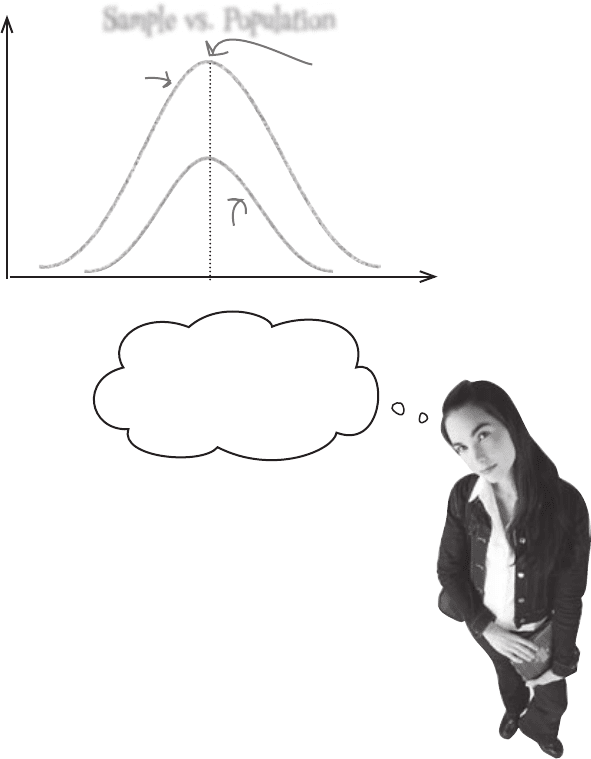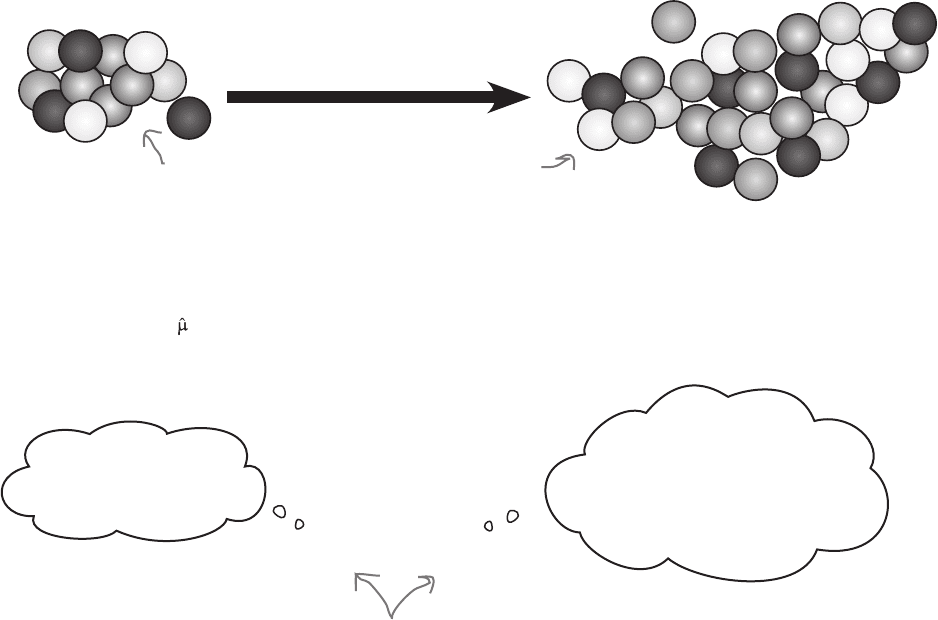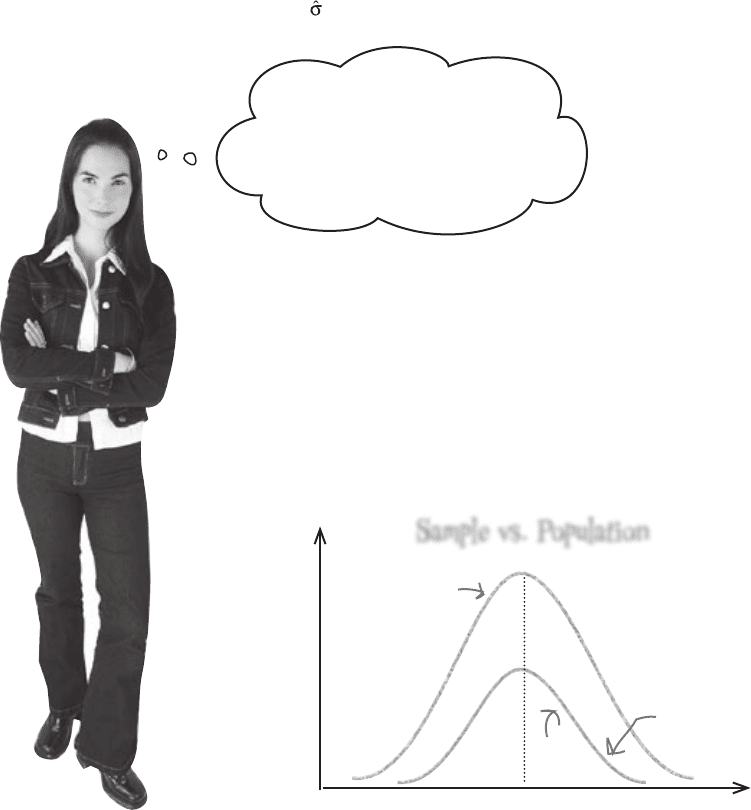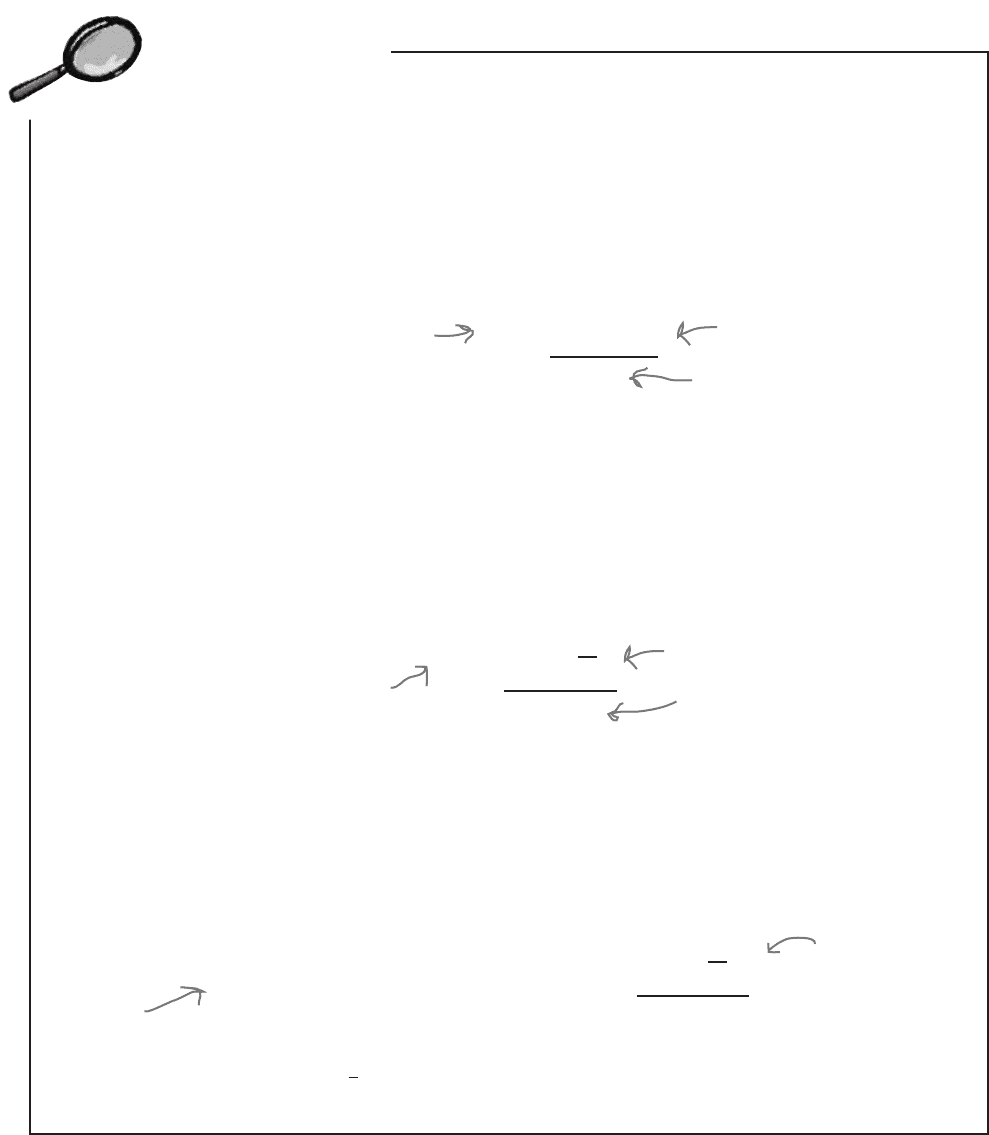Griffiths D. Head First Statistics
Подождите немного. Документ загружается.


this is a new chapter 441
estimating populations and samples
11
Making Predictions
...I mean, men! They’re all
the same. Once you’ve met
one, you’ve met them all!
Wouldn’t it be great if you could tell what a population was
like, just by taking one sample?
Before you can claim full sample mastery, you need to know how to use your samples
to best effect once you’ve collected them. This means using them to accurately predict
what the population will be like and coming up with a way of saying how reliable your
predictions are. In this chapter, we’ll show you how knowing your sample helps you get to
know your population, and vice versa.

442 Chapter 11
So how long does flavor really last for?
With your help, Mighty Gumball has pulled together an unbiased
sample of super-long-lasting gumballs. They’ve tested each of the
gumballs in the sample and collected lots of data about how long
gumball flavor within the sample lasts.
There’s just one problem...
I don’t care how long flavor lasts in the sample.
What I do care about is flavor duration in the
population. That way, I can say how much longer our
gumballs last than the competing brand.
To satisfy the CEO, we’re going to need to find both the mean
and the variance of flavor duration in the whole Mighty Gumball
population.
Here’s the data we gathered from the sample. How do you think
we can use it to tell us what the mean of the population is?
Take a look at the data. How would you use this data to estimate the mean
and variance of the population? How reliable do you think your estimate will
be? Why?
61.9 62.6 63.3 64.8 65.1
66.4 67.1 67.2 68.7 69.9
Here’s how long
flavor lasts for
in minutes
making estimates using a sample
Mighty Gumball’s pugilistic CEO

you are here 4 443
estimating populations and samples
So how can we use the results of the sample taste test to tell us the mean
amount of time gumball flavor lasts for in the general gumball population?
The answer is actually pretty intuitive. We assume that the mean flavor
duration of the gumballs in the sample matches that of the population. In
other words, we find the mean of the sample and use it as the mean for the
population too.
Here’s a sketch showing the distribution of the sample, and what you’d
expect the distribution of the population to look like based on the sample.
You’d expect the distribution of the population to be a similar shape to
that of the sample, so you can assume that the mean of the sample and
population have about the same value.
So are you saying that
the mean of the sample
exactly matches the mean
of the population?
We can’t say that they exactly match, but
it’s the best estimate we can make.
Based on what we know, the mean of the sample is the best
estimate we can make for the mean of the population. It’s
the most likely value for the population mean that we can
come up with based on the information that we have.
The mean of the sample is called a point estimator for
the population mean. In other words, it’s a calculation
based on the sample data that provides a good estimate for
the mean of the population.
You’d expect the
population and sample mean
to be about the same
Sample vs. Population
flavor duration
frequency
Sample
Population
Let’s start by estimating the population mean

444 Chapter 11
Up until now, we’ve been dealing with actual values of population parameters
such as the mean, μ, or the variance, σ
2
. We’ve either been able to calculate
these for ourselves, or we’ve been told what they are.
This time around we don’t know the exact value of the population parameters.
Instead of calculating them using the population, we estimate them using
the sample data instead. To do this, we use point estimators to come up with a
best guess of the population parameters.
A point estimator of a population parameter is some function or calculation
that can be used to estimate the value of the population parameter. As an
example, the point estimator of the population mean is the mean of the sample,
as we can use the sample mean to estimate the population mean.
Point estimators use
sample data...
...to estimate the
population parameters.
We differentiate between an actual population parameter and its point
estimator using the ^ symbol. As an example, we use the symbol μ to represent
the population mean, and to represent its estimator. So to show that you’re
dealing with the point estimator of a particular population parameter, take the
symbol of the population parameter, and top it with a ^.
μ
I’m the population
mean, the real thing.
See this hat I’m wearing?
It means I’m a point estimator.
If you don’t have the exact
value of the mean, then I’m the
next best thing.
μ
^
The point estimator for the
population mean looks like the mean
itself, except it’s topped with a ^.
Point estimators can approximate population parameters
all about point estimators

you are here 4 445
estimating populations and samples
x = Σx
n
x is the mean of
the sample.
Add together the numbers
in the sample, and divide by
how many there are.
It occurs to me that we have a
symbol for the population mean and
one for its point estimator. Is there
a symbol for the sample mean too?
There’s a shorthand way of writing the sample mean.
The symbol μ has a very precise meaning. It’s the mean of the population.
We have a different way to represent the mean of the sample so that we
don’t get confused about which mean we’re talking about. To represent the
sample mean, we use the symbol x (pronounced “x bar”). That way, we
know that if someone refers to μ, they’re referring to the population mean,
and if they refer to x, they’re referring to the sample mean.
x is the sample equivalent of μ, and you calculate it in the same way you
would the population mean. You add together all the data in your sample,
and then divide by however many items there are. In other words, if your
sample size is n,
We can use this to write a shorthand expression for the point estimator for
the population. Since we can estimate the population mean using the mean
of the sample, this means that
= x
Use the sample data to estimate the value of the population
mean. Here’s a reminder of the data:
61.9 62.6 63.3 64.8 65.1 66.4 67.1 67.2 68.7 69.9
We estimate the mean
of the population...
...using the mean of the sample.

446 Chapter 11
Use the sample data to estimate the value of the population
mean. Here’s a reminder of the data:
Q:
Surely the mean is just the mean.
Why are there so many different symbols
for it?
A: There are three different concepts at
work. There’s the mean of the population,
the mean of the sample, and the point
estimator for the population mean.
The population mean is represented
by μ. This is the sort of mean that we’ve
encountered throughout the book so far, and
you find it by adding together all the data in
the population and dividing by the size of the
population.
The sample mean is represented by x.
You find it in the same way that you find μ,
except that this time your data comes from
a sample. To calculate x, you add together
the data in your sample, and divide by the
size of it.
The point estimator for μ is represented by
μ. It’s effectively a best guess for what you
think the population mean is, based on the
sample data.
Q:
So does that mean that we can find
μ by just taking the mean of a sample?
A: We can’t find the exact value of
μ using a sample, but if the sample is
unbiased, it gives us a very good estimate.
In other words, we can use the sample data
to find μ, not the true value of μ itself.
Q:
But what about if the sample is
biased? How do we come up with an
estimate for μ then?
A: This is where it’s important to make
your sample as unbiased as possible. If all
the data you have comes from your sample,
then that’s what you need to use as the
basis for your estimate. If your sample is
biased, then this means that your estimate
for μ is likely to be inaccurate, and it may
lead you into making wrong decisions.
Q:
Does the size of the sample matter?
A: In general, the larger the size of
your sample, the more accurate your point
estimator is likely to be.
61.9 62.6 63.3 64.8 65.1 66.4 67.1 67.2 68.7 69.9
We can estimate the population mean by calculating the mean of the sample.
μ = x = 61.9 + 62.6 + 63.3 + 64.8 + 65.1 + 66.4 + 67.1 + 67.2 + 68.7 + 69.9
10
= 657/10
= 65.7
^
^
^
solutions and questions
μ is the mean of the
population, x is the
mean of the sample,
and μ is the point
estimator for μ.
^

you are here 4 447
estimating populations and samples
A point estimator is an estimate for the value of a
population parameter, derived from sample data.
The ^ symbol is added to the population parameter
when you’re talking about its point estimator. As an
example, the point estimator for μ is μ.
The mean of a sample is represented as x. To find the
mean of the sample, use the formula
x = Σx
n
where x represents the values in the sample, and n is
the sample size.
The point estimator for the population mean is found by
calculating x. In other words,
μ = x
This means that if you want a good estimate for the true
value of the population mean, you can use the mean of
the sample.
^
^
This looks great! We can use your
work in our television commercials to say
how long gumball flavor lasts for, and it
beats our main rival, hands down. Just one
question: how much variation do you expect
there to be?
You’ve come up with a good estimate
for the population mean, but what
about the variance?
If we can come up with a good estimate for the
population variance, then the CEO will be able to
tell how much variation in flavor duration there’s
likely to be in the gumball population, based on
the results of the sample data.

448 Chapter 11
The variance of the data in the sample may not be
the best way of estimating the population variance.
You already know that the variance of a set of data measures the way in
which values are dispersed from the mean. When you choose a sample,
you have a smaller number of values than with the population, and since
you have fewer values, there’s a good chance they’re more clustered
around the mean than they would be in the population. More extreme
values are less likely to be in your sample, as there are generally fewer of
them.
That’s easy. The variance of the
sample is bound to be the same
as that of the population. We can
use the sample variance to estimate
the population variance.
Let’s estimate the population variance
So far we’ve seen how we can use the sample mean to estimate the mean
of the population. This means that we have a way of estimating what the
mean flavor duration is for the super-long-lasting gumball population.
To satisfy the Mighty Gumball CEO, we also need to come up with a good
estimate for the population variance.
So what can we use as a point estimator for the population variance? In
other words, how can we use the sample data to find
2
?
So what would be a better estimate of the population variance?
Sample vs. Population
flavor duration
frequency
Sample
Population
There are fewer values
in the sample, so there’s
a good chance that
more extreme values will
be excluded.
point estimator for population variance

you are here 4 449
estimating populations and samples
The problem with using the sample variance to estimate that of the population
is that it tends to be slightly too low. The sample variance tends to be slightly
less than the variance of the population, and the degree to which this holds
depends on the number of values in the sample. If the number in the sample
is small, there’s likely to be a bigger difference between the sample and
population variances than if the size of the sample is large.
What we need is a better way of estimating the variance of the population,
some function of the sample data that gives a slightly higher result than the
variance of all the values in the sample.
In other words, we take each item in the sample, subtract the sample mean, and
then square the result. We then add all of the results together, and divide by the
number of items in the sample minus 1. This is just like finding the variance of
the values in the sample, but dividing by n – 1 instead of n.
So what is the estimator?
Rather than take the variance of all the data in the sample to estimate the
population variance, there’s something else we can use instead. If the size of
the sample is n, we can estimate the population variance using
σ
2
= Σ(x - x)
2
n - 1
^
So how is that a
better estimate?
This formula is a closer match to the value of the
population variance.
Dividing a set of numbers by n – 1 gives a higher result than
dividing by n, and this difference is most noticeable when n is fairly
small. This means that the formula is similar to the variance of the
sample data, but gives a slightly higher result.
The population variance tends to be higher than the variance of
the data in the sample. This means that this formula is a slightly
better point estimator for the population variance.
Take each item in the sample, subtract the sample mean,
square the result, then add the lot together.
Divide by the number in the sample minus 1.
Estimator for the
population variance
We need a different point estimator than sample variance

450 Chapter 11
Variance Up Close
Estimating the population variance
If you need to estimate the variance of a population using sample data, use
σ
2
= Σ(x - x)
2
n - 1
n - 1, not n, where n is the size of the
sample. This time it’s an estimate..
Instead of calculating the variance of an actual population of n values, you
have to estimate the variance of the population, based on the sample of data
you have. To make you estimate a bit more accurate, you divide by n - 1
instead of n, as this gives a slightly higher result.
The formula for the population variance point estimator is usually written
s
2
, so
Sample mean
Point estimator for
the population variance,
based on your sample.
Knowing what formula you should use to find the variance can be confusing.
There’s one formula for population variance σ
2
, and a slightly different one
for its point estimator σ
2
. So which formula should you use when?
Population variance
If you want to find the exact variance of a population and you have data for
the whole population, use
σ
2
= Σ(x - μ)
2
n
Population mean
Size of the population
In this situation, you have all the data for your population. You know what
the mean is for your population, and you want to find the variance of all of
these values. This is the calculation that you’ve seen throughout this book
so far.
Population variance
^
^
s
2
= Σ(x - x)
2
n - 1
where
σ
2
= s
2
^
This is similar to using x to represent the sample mean.
Point estimator
for the
population
variance
s
2
gives the
formula based on
the sample data
variance in depth
